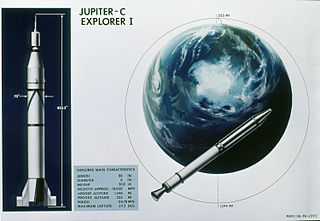
Explorer 1 was the first satellite launched by the United States in 1958 and was part of the U.S. participation in the International Geophysical Year (IGY). The mission followed the first two satellites the previous year; the Soviet Union's Sputnik 1 and Sputnik 2, beginning the Cold War Space Race between the two nations.

Explorer 4 was an American satellite launched on 26 July 1958. It was instrumented by Dr. James van Allen's group. The Department of Defense's Advanced Research Projects Agency (ARPA) had initially planned two satellites for the purposes of studying the Van Allen radiation belts and the effects of nuclear explosions upon these belts, however Explorer 4 was the only such satellite launched as the other, Explorer 5, suffered launch failure.
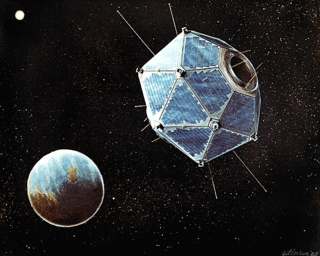
Vela was the name of a group of satellites developed as the Vela Hotel element of Project Vela by the United States to detect nuclear detonations to monitor compliance with the 1963 Partial Test Ban Treaty by the Soviet Union.

Explorer 35,, was a spin-stabilized spacecraft built by NASA as part of the Explorer program. Designed for the study of the interplanetary plasma, magnetic field, energetic particles, and solar X-rays, from lunar orbit.
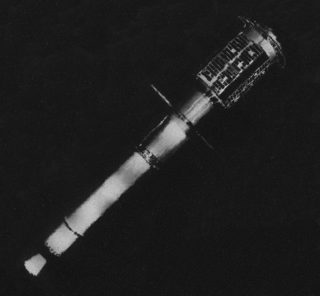
Explorer 11 was a NASA satellite that carried the first space-borne gamma-ray telescope. This marked the beginning of space gamma-ray astronomy. Launched on 27 April 1961 by a Juno II, the satellite returned data until 17 November 1961, when power supply problems ended the science mission. During the spacecraft's seven-month lifespan it detected twenty-two events from gamma-rays and approximately 22,000 events from cosmic radiation.

ATS-6 was a NASA experimental satellite, built by Fairchild Space and Electronics Division It has been called the world's first educational satellite as well as world's first experimental Direct Broadcast Satellite as part of the Satellite Instructional Television Experiment between NASA and Indian Space Research Organisation (ISRO). It was launched May 30, 1974, and decommissioned July 1979. At the time of launch, it was the most powerful telecommunication satellite in orbit. ATS-6 carried no fewer than 23 different experiments, and introduced several breakthroughs. It was the first 3-axis stabilized spacecraft in geostationary orbit. It was also the first to use experimentally with some success electric propulsion in geostationary orbit. It also carried several particle physics experiments, including the first heavy ion detector in geostationary orbit.
Kosmos 111, E-6S No.204, was the first Soviet attempt to orbit a spacecraft around the Moon. The design was similar to the future successful Luna 10 spacecraft. Kosmos 111 was produced in less than a month, one of two spacecraft developed from the E-6 lander bus in a crash program to upstage America's Lunar Orbiter series and to commemorate the 23rd Congress of the Communist Party of the Soviet Union (CPSU), held in March 1966.
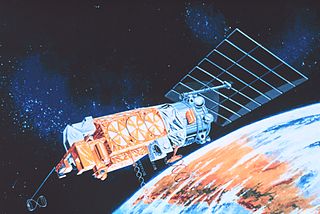
NOAA-7, known as NOAA-C before launch, was an American operational weather satellite for use in the National Operational Environmental Satellite System (NOESS) and for the support of the Global Atmospheric Research Program (GARP) during 1978-1984. The satellite design provided an economical and stable Sun-synchronous platform for advanced operational instruments to measure the atmosphere of Earth, its surface and cloud cover, and the near-space environment. An earlier launch, NOAA-B, was scheduled to become NOAA-7, however NOAA-B failed to reach its required orbit.

Explorer 18, also called IMP-A, IMP-1, Interplanetary Monitoring Platform-1 and S-74, was a NASA satellite launched as part of the Explorer program. Explorer 18 was launched on 27 November 1963 from Cape Canaveral Air Force Station (CCAFS), Florida, with a Thor-Delta C launch vehicle. Explorer 18 was the first satellite of the Interplanetary Monitoring Platform (IMP). Explorer 21 (IMP-B) launched in October 1964 and Explorer 28 (IMP-C) launched in May 1965 also used the same general spacecraft design.

An X-ray astronomy satellite studies X-ray emissions from celestial objects, as part of a branch of space science known as X-ray astronomy. Satellites are needed because X-radiation is absorbed by the Earth's atmosphere, so instruments to detect X-rays must be taken to high altitude by balloons, sounding rockets, and satellites.

Explorer 26 was a NASA satellite launched on 21 December 1964, as part of NASA's Explorer program. Its primary mission was to study the Earth's magnetic field.
Hitchhiker 2 was a satellite launched by U.S. Air Force. It was launched with the aim of studying and measuring cosmic radiation. The satellite was the second successful satellite of the P-11 program, following the failure of the first Hitchhiker satellite in March 1963. It was launched on October 29, 1963 from Vandenberg Air Force Base, California, on a Thor-Agena launch vehicle.

Explorer 15, also called EPE-C or Energetic Particles Explorer-C, was a NASA satellite launched as part of the Explorer program. Explorer 15 was launched on 27 October 1962, at Cape Canaveral Air Force Station, Florida, United States, with a Thor-Delta A.
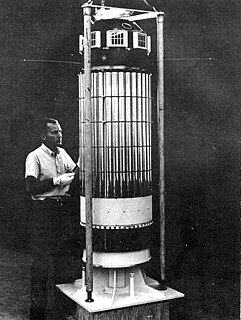
Explorer 16, also called S-55B, was a NASA satellite launched as part of the Explorer program. Explorer 16 was launched on 16 December 1962, at 14:33:04 GMT, from Wallops Flight Facility, Virginia, with a Scout X-3.

Explorer 21, also called IMP-B, IMP-2 and Interplanetary Monitoring Platform-2, was a NASA satellite launched as part of Explorer program. Explorer 21 was launched on 4 October 1964, at 03:45:00 GMT from Cape Canaveral (CCAFS), Florida, with a Thor-Delta C launch vehicle. Explorer 21 was the second satellite of the Interplanetary Monitoring Platform, and used the same general design as its predecessor, Explorer 18 (IMP-A), launched the previous year, in October 1964. The following Explorer 28 (IMP-C), launched in May 1965, also used a similar design.
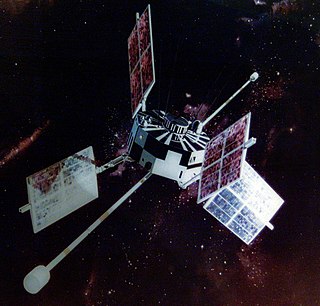
Explorer 34, was a NASA satellite launched as part of Explorer program. Explorer 34 as launched on 24 May 1967 from Vandenberg Air Force Base, California, with Thor-Delta E1 launch vehicle. Explorer 34 was the fifth satellite launched as part of the Interplanetary Monitoring Platform program, but was known as "IMP-4" because the preceding launch was more specifically part of the "Anchored IMP" sub-program. The spacecraft was put into space between the launches of Explorer 33 in 1966 and Explorer 35 in July 1967, but the next satellite to use Explorer 34's general design was Explorer 41, which flew in 1969.

Explorer 41, also called as IMP-G and IMP-5, was a NASA satellite launched as part of Explorer program. Explorer 41 as launched on 21 June 1969 on Vandenberg AFB, California, with a Thor-Delta E1 launch vehicle. Explorer 41 was the seventh satellite launched as part of the overall Interplanetary Monitoring Platform series, though it received the post-launch designation "IMP-5" because two previous flights had used the "AIMP" designation instead. It was preceded by the second of those flights, Explorer 35, launched in July 1967. Its predecessor in the strict IMP series of launches was Explorer 34, launched in May 1967, which shared a similar design to Explorer 41. The next launch was of an IMP satellite was Explorer 43 in 1971.
NOAA-11, known as NOAA-H before launch, was an American weather satellite operated by the National Oceanic and Atmospheric Administration (NOAA) for use in the National Operational Environmental Satellite System (NOESS) and for support of the Global Atmospheric Research Program (GARP) during 1978–1984. It was the fourth of the Advanced TIROS-N series of satellites. The satellite design provided an economical and stable Sun-synchronous platform for advanced operational instruments to measure the atmosphere of Earth, its surface and cloud cover, and the near-space environment.

Elektron ('electron'), in American sources sometimes called Electron, was the first Soviet multiple satellite program, comprising two identical pairs of particle physics satellites launched by the Soviet Union in 1964. The four spacecraft simultaneously monitored the lower and upper Van Allen radiation belts and returned a considerable volume of data regarding radiation in space and atmospheric conditions to an altitude of more than 58,000 kilometres (36,000 mi) above the Earth. Two of the four launched satellites are still in orbit as of 2020, the other two having reentered.

The Environmental Research Satellite program was a series of small satellites initially operated by the United States Air Force Office of Aerospace Research. Designed to be launched "piggyback" to other satellites during launch, detaching once in orbit, they were the smallest satellites launched to date—what would today be classified as microsatellites. 33 ERS satellites in six different series were launched between 1962 and 1971, conducting scientific research and serving as test beds to investigate the reliability of new spacecraft components.

















